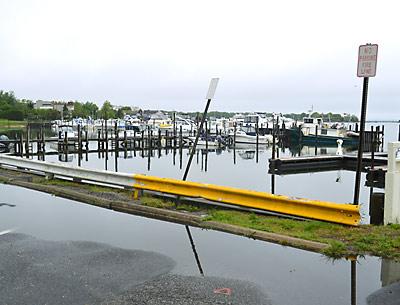Clam Ban in Sag Harbor Coves After Biotoxin Found

A recent shellfish ban in Sag Harbor Cove was the subject of intense discussion at a meeting Monday night of the village’s harbor committee. “We have been too slack,” said Bruce Tait, the committee chairman, about overpopulation, leaching septic tanks, fertilizer, and cesspools. “People can die from this bacteria,” he said. “This is serious.”
Dennis Downs, an attorney who was in the audience for another issue, agreed that the closing of the enclosed coves was very troubling. “A friend of mine who lives in Bay Point saw kids clamming in Upper Cove,” he said. “The clams could be poisonous and kill you.”
The committee wondered whether enough was being done to inform the public. “It’s a deadly bacteria,” Mr. Tait said, “If you don’t read the paper, you’re not told.” Kevin McAllister, the Peconic Baykeeper, agreed with that opinion. “The average person not tuned into the media would not know,” he said on Tuesday. “It is a serious public health threat.”
According to the New York State Department of Environmental Conservation, “Paralytic shellfish poisoning is a very serious illness that can start with a tingling, or numb feeling, in the lips, tongue and face, within minutes to a few hours after eating contaminated shellfish. Depending on the amount of toxin that’s ingested, the tingling can spread to the fingers and toes, followed by paralysis of the arms and legs and difficulty breathing. Some people have the feeling that they’re floating or may become nauseated. If enough toxins are consumed, the paralysis can spread to the chest and abdomen and, when the muscles used for breathing become paralyzed, the illness can result in death.”
Mussels, clams, oysters, and scallops can accumulate unsafe levels of the toxin that causes paralytic shellfish poisoning, the D.E.C. said. Whelks and other gastropods (moon snails), which prey upon shellfish, can also have toxic levels. The meat of crustaceans, such as lobsters and crabs, is not known to accumulate biotoxins, but the tomalley, or green gut, can have unsafe levels and should be discarded.
The harbor committee suggested among other things that signs be placed in stores where clam rakes are sold to alert the public to the danger. “It’s important that people know they can’t go clamming in these waters,” said Mr. Tait.
Mr. Downs, a Sag Harbor resident for 30 years, told the gathering that the D.E.C. marks a closed area with a post, painted red on top. “People don’t know what that means,” he said. In Upper Cove, Morris Cove, and Payne’s Creek, “I see them clamming all the time, they don’t know what the red pole means. Maybe the D.E.C. can put up a sign,” he said.
Tom Hamilton, a harbor committee member, suggested a packet of information for the public, stating the best practices for fertilizer and pesticide use, which the chairman called “a very good idea.”
“We are reaching the tipping point,” Mr. McAllister said on Tuesday. “This is here,” he said, speaking of fallout from land development since the ’60s. “Nitrogen is the culprit,” he said confidently, citing the work of Christopher Gobler, whom he called “a premier algae-bloom researcher” at the State University at Stony Brook. “It’s from wastewater.”
Karen Graulich, a marine biologist for the D.E.C., wrote in an e-mail that “although Alexandrium is a naturally occurring organism that has been identified in many estuaries throughout Long Island, the reasons for its recent blooms in certain locations are not well understood.” Jim Ryan of Response Marine in Greenport, who forwarded that email, has offered the D.E.C. remediation assistance in the affected areas. His company has worked extensively on marine environmental projects, including oil spills in the Gulf of Mexico.
Aphrodite Montalvo, a citizen participation specialist for the D.E.C., explained by e-mail that the department initially sampled oysters in Sag Harbor Cove and is now sampling mussels from a monitoring station at a private facility. It is the shellfish, not the water, that is tested, she said.
Both the water and the shellfish may appear to be fine. According to the D.E.C.’s fact sheet, paralytic shellfish poisoning is rarely associated with discoloration of water. The toxin can be present in high amounts even when the water is clear, and it can remain in shellfish long after an algae bloom has dissipated, though they may continue to look perfectly normal.
“State-of-the-art treatment is necessary,” said Mr. McAllister. He suggested placing a septic system underground to treat 30 to 50 houses in the Redwood area, and upgrading existing systems. “We have to start talking about strategies,” he said. “Innovative progressive technology is necessary. The community needs to ask itself, ‘What value do we place on clean water?’ ”
“We live in a water-based economy,” the baykeeper concluded. “If it’s unswimmable and unfishable, who will come here? They will go somewhere else.”
